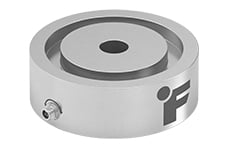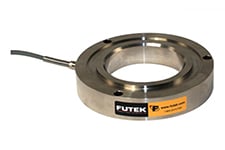Why should you use anchor load cells for retaining walls?
Retaining walls are structures used to hold back soil or other materials and prevent landslides or erosion. Tieback retaining walls are a common type of retaining wall that uses tieback anchors to provide additional stability. These anchors are typically made of steel rods or cables that are inserted into the soil behind the wall and attached to the wall itself. The anchor rod or cable is then tensioned to provide additional resistance against the soil pressure behind the wall. The anchoring zone is the area behind the wall where the anchor is installed and the hydraulic jack is typically used to tension the anchor.
Why is it Important to Measure Anchor Tension?
It’s imperative that the tieback anchor holds the correct amount of tension force. Measuring the tension force is critical to understanding the stability of the retaining wall. If the tension force is too low, the retaining wall may fail under the pressure of the soil that it is supposed to retain. If the tension force is too high, it can cause damage to the retaining wall and weaken the structure. Load cell sensors (or force sensors) are used to measure tensile loads in tie-back anchors and rockbolts, or compressive loads in structures. The load cells are typically installed between the anchor rod or cable and the retaining wall. The data collected by the sensor is then used to ensure that the anchor is installed correctly and that the retaining wall is stable.
In addition to measuring the tension force during installation, load cells can also be used to monitor the tension force continuously. Over time, the tension force in the anchor will likely change due to several factors such as natural ground movement, soil conditions, severe weather, or changes in the load (addition or reduction) applied on the retaining wall. By continuously monitoring the tension force in the anchor, engineers can identify any changes and take appropriate action to maintain the stability of the retaining wall.
How Load Cells can be used in this application?
Load Cells are used to measure tensile loads in tie-back anchors and rockbolts, or compressive loads in structures. Typical applications include:
- Anchored retaining walls
- Anchoring systems for deep excavations
- Tie-down anchors for buoyant structures
- Rock bolts and soil nails monitoring in mines and slope stabilization
- Load monitoring in structures
FUTEK’s LTH500 is a low-profile through-hole (or donut) load cell sensor that is designed for applications that require the load-bearing structure to pass through the sensor. It features multiple strain gauges that optimize the model’s performance and significantly reduce the influence of extraneous loads.
The LTH500 is ideal for inline applications that require a sensor that can handle eccentric or extraneous loads and still maintain a high level of accuracy and reliability. It features an integrated 4-pin micro connector for easy cable connection and disconnection and is rated IP67 for moisture protection.
It is available in a wide range of capacities that range from 2000 to 50000lb and in a variety of inner diameter sizes from 1/8 in to 1-1/2in (3.4 to 38.1mm). See the “How it works” section below for further information regarding the sensor installation.
How it Works
FUTEK LTH Series Thru Hole Load Cells cells are designed to be installed between the anchor bolt and the retaining wall. The surface against which the load cell bears should be smooth and perpendicular to the axis of the anchor or tieback. Hence a seating pad, bearing plate and load distribution plate are used to ensure the tension is equally distributed and perpendicular to the load cell measuring axis (axially to the anchor rod).
Once the anchor load cell is installed, a hydraulic jack is used to tension the anchor rod or cable. As the tension force is applied, the load cell measures the force being applied to the anchor.
The load cell sensors are connected to either an analog or a digital signal conditioner. It allows the mV/V sensor of the weight sensor to be connected to a data acquisition system (DAQ) or PLC. For remote applications, a BLE wireless transmitter can also be used.
The data collected by the FUTEK LTH load cell can then be used to ensure that the anchor is installed correctly and that the retaining wall is stable. In addition to measuring the tension force during installation, load cells can also be used to monitor the tension force over time. By regularly monitoring the tension force in the anchor, engineers can identify any changes and take appropriate action to maintain the stability of the retaining wall.
Products in Use
LTH500 Donut/Through Hole Load Cell
IAA Series Strain Gauge Analog Amplifier with Voltage Output
Contact Us
Please Contact Us with questions.
Why should you use anchor load cells for retaining walls?
Retaining walls are structures used to hold back soil or other materials and prevent landslides or erosion. Tieback retaining walls are a common type of retaining wall that uses tieback anchors to provide additional stability. These anchors are typically made of steel rods or cables that are inserted into the soil behind the wall and attached to the wall itself. The anchor rod or cable is then tensioned to provide additional resistance against the soil pressure behind the wall. The anchoring zone is the area behind the wall where the anchor is installed and the hydraulic jack is typically used to tension the anchor.
Why is it Important to Measure Anchor Tension?
It’s imperative that the tieback anchor holds the correct amount of tension force. Measuring the tension force is critical to understanding the stability of the retaining wall. If the tension force is too low, the retaining wall may fail under the pressure of the soil that it is supposed to retain. If the tension force is too high, it can cause damage to the retaining wall and weaken the structure. Load cell sensors (or force sensors) are used to measure tensile loads in tie-back anchors and rockbolts, or compressive loads in structures. The load cells are typically installed between the anchor rod or cable and the retaining wall. The data collected by the sensor is then used to ensure that the anchor is installed correctly and that the retaining wall is stable.
In addition to measuring the tension force during installation, load cells can also be used to monitor the tension force continuously. Over time, the tension force in the anchor will likely change due to several factors such as natural ground movement, soil conditions, severe weather, or changes in the load (addition or reduction) applied on the retaining wall. By continuously monitoring the tension force in the anchor, engineers can identify any changes and take appropriate action to maintain the stability of the retaining wall.
How Load Cells can be used in this application?
Load Cells are used to measure tensile loads in tie-back anchors and rockbolts, or compressive loads in structures. Typical applications include:
- Anchored retaining walls
- Anchoring systems for deep excavations
- Tie-down anchors for buoyant structures
- Rock bolts and soil nails monitoring in mines and slope stabilization
- Load monitoring in structures
FUTEK’s LTH500 is a low-profile through-hole (or donut) load cell sensor that is designed for applications that require the load-bearing structure to pass through the sensor. It features multiple strain gauges that optimize the model’s performance and significantly reduce the influence of extraneous loads.
The LTH500 is ideal for inline applications that require a sensor that can handle eccentric or extraneous loads and still maintain a high level of accuracy and reliability. It features an integrated 4-pin micro connector for easy cable connection and disconnection and is rated IP67 for moisture protection.
It is available in a wide range of capacities that range from 2000 to 50000lb and in a variety of inner diameter sizes from 1/8 in to 1-1/2in (3.4 to 38.1mm). See the “How it works” section below for further information regarding the sensor installation.


